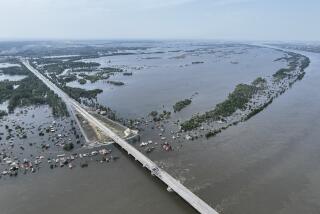Russians In Hueneme to Study Spills : Petroleum: Officials meet with a nonprofit company formed after the Exxon Valdez disaster.
- Share via
As an environmentalist in Russia’s most important oil region, scientist Vladimir P. Melnikov is trying, slowly, to reverse a long history of ecological destruction.
*
His first challenge is educating fellow environmentalists. His second is persuading oil industry executives that change can occur, even in the face of a crippled economy.
On Friday, Melnikov and nine other officials from western Siberia visited the Port of Hueneme as part of a crash course on the latest technology for cleaning up major disasters at sea.
Accompanied by two interpreters, the delegation met with members of the Marine Spill Response Corp.--a nonprofit company formed in the wake of the Exxon Valdez disaster.
Aboard the center’s $13-million California Responder ship, they inspected skimmer heads used for vacuuming oil from the ocean and rubber booms used to contain a floating slick.
In a 90,000-square-foot warehouse, they peeked at rigid-hulled, inflatable boats used to place the booms and transport people and supplies.
To the delegation, the quality of such equipment was impressive. But equally stunning was the fact that the corporation is a $1-billion joint venture between giant oil companies.
During a question-and-answer session before the tour, the Russian ecologists--many of whom head departments within regional governments--asked about American regulations for reporting spills.
“You must understand, the law in the U.S. is that if you create the sheen of oil on the water, you must report it,” said Lindon A. Onstad, regional manager for the center.
Onstad also told the delegation that approximately 1,000 spills are reported in the U.S. each year. However, only about 5% of those are big enough to require a full-scale cleanup effort.
*
In 1993, he said, the nationwide Marine Spill Response Center tackled six spills, all of which were larger than 1,200 barrels or too big for local agencies to handle.
Melnikov, who heads the Tyumen Scientific Center, said ruptured pipelines and leaking reservoirs are responsible for the majority of the disasters that have scarred the Western Siberian landscape. In some areas, vast stretches of land are covered by lakes of oil and oil-byproduct.
Almost all of the pipelines and drilling equipment are old and have deteriorated over time, he said.
“For many years . . . any attention at all to the environment was completely subordinate to the oil industry,” he said.
Awareness of the environment is growing, he said, but it is overwhelmed by the need for greater oil production to support the struggling economy.
*
“Because of all of this,” Melnikov said, “our environment is not changing at all.
“In order to make up for lost time, we need vast financial resources,” he added.
The delegation was scheduled to leave Ventura County today for Alaska, where it will tour oil fields on the North Slope, visit an offshore rig and meet with private environmental groups.
The Russian delegation’s trip is being funded through the U.S. Agency for International Development as part of a $2.5-billion economic aid program to the countries of the new Russian Federation.
As part of the same program, a team of Americans visited western Siberia earlier this year. Their mission was similar to this week’s visit: to bring western environmental technology to the Russian region.
More to Read
Sign up for Essential California
The most important California stories and recommendations in your inbox every morning.
You may occasionally receive promotional content from the Los Angeles Times.













